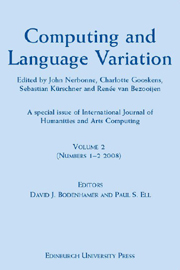Book contents
- Frontmatter
- Contents
- From the Editors
- Notes on Contributors
- 1 Introduction: Language Variation Studies and Computational Humanities
- 2 Panel Discussion on Computing and the Humanities
- 3 Making Sense of Strange Sounds: (Mutual) Intelligibility of Related Language Varieties. A Review
- 4 Phonetic and Lexical Predictors of Intelligibility
- 5 Linguistic Determinants of the Intelligibility of Swedish Words among Danes
- 6 Mutual Intelligibility of Standard and Regional Dutch Language Varieties
- 7 The Dutch-German Border: Relating Linguistic, Geographic and Social Distances
- 8 The Space of Tuscan Dialectal Variation: A Correlation Study
- 9 Recognising Groups among Dialects
- 10 Comparison of Component Models in Analysing the Distribution of Dialectal Features
- 11 Factor Analysis of Vowel Pronunciation in Swedish Dialects
- 12 Representing Tone in Levenshtein Distance
- 13 The Role of Concept Characteristics in Lexical Dialectometry
- 14 What Role does Dialect Knowledge Play in the Perception of Linguistic Distances?
- 15 Quantifying Dialect Similarity by Comparison of the Lexical Distribution of Phonemes
- 16 Corpus-based Dialectometry: Aggregate Morphosyntactic Variability in British English Dialects
8 - The Space of Tuscan Dialectal Variation: A Correlation Study
Published online by Cambridge University Press: 12 September 2012
- Frontmatter
- Contents
- From the Editors
- Notes on Contributors
- 1 Introduction: Language Variation Studies and Computational Humanities
- 2 Panel Discussion on Computing and the Humanities
- 3 Making Sense of Strange Sounds: (Mutual) Intelligibility of Related Language Varieties. A Review
- 4 Phonetic and Lexical Predictors of Intelligibility
- 5 Linguistic Determinants of the Intelligibility of Swedish Words among Danes
- 6 Mutual Intelligibility of Standard and Regional Dutch Language Varieties
- 7 The Dutch-German Border: Relating Linguistic, Geographic and Social Distances
- 8 The Space of Tuscan Dialectal Variation: A Correlation Study
- 9 Recognising Groups among Dialects
- 10 Comparison of Component Models in Analysing the Distribution of Dialectal Features
- 11 Factor Analysis of Vowel Pronunciation in Swedish Dialects
- 12 Representing Tone in Levenshtein Distance
- 13 The Role of Concept Characteristics in Lexical Dialectometry
- 14 What Role does Dialect Knowledge Play in the Perception of Linguistic Distances?
- 15 Quantifying Dialect Similarity by Comparison of the Lexical Distribution of Phonemes
- 16 Corpus-based Dialectometry: Aggregate Morphosyntactic Variability in British English Dialects
Summary
Abstract The paper illustrates the results of a correlation study focusing on linguistic variation in an Italian region, Tuscany. By exploiting a multilevel representation scheme of dialectal data, the study analyses attested patterns of phonetic and morpho-lexical variation with the aim of testing the degree of correlation between a) phonetic and morpho-lexical variation, and b) linguistic variation and geographic distance. The correlation analysis was performed by combining two complementary approaches proposed in dialectometric literature, namely by computing both global and place-specific correlation measures and by inspecting their spatial distribution. Achieved results demonstrate that phonetic and morpho-lexical variations in Tuscany seem to follow a different pattern than encountered in previous studies.
INTRODUCTION
It is a well-known fact that different types of features contribute to the linguistic distance between any two locations, which can differ for instance with respect to the word used to denote the same object or the phonetic realisation of a particular word. Yet, the correlation between different feature types in defining patterns of dialectal variation represents an area of research still unexplored. In traditional dialectology, there is no obvious way to approach this matter beyond fairly superficial and impressionistic observations. The situation changes if the same research question is addressed in the framework of dialectometric studies, where it is possible to measure dialectal distances with respect to distinct linguistic levels and to compute whether and to what extent observed distances correlate.
- Type
- Chapter
- Information
- Computing and Language VariationInternational Journal of Humanities and Arts Computing Volume 2, pp. 135 - 152Publisher: Edinburgh University PressPrint publication year: 2009

